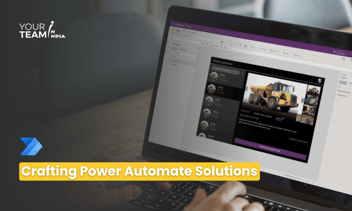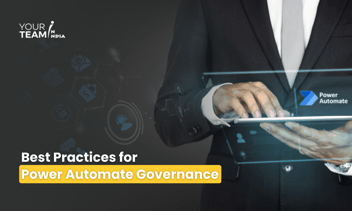Quick Summary: Dive into the realm of Power Automate with a focus on security considerations. This article explores essential guidelines and best practices to fortify your automated processes, ensuring data integrity and safeguarding against potential threats. Elevate your workflow with confidence in a secure Power Automate environment.
Introduction
In the rapidly evolving landscape of digital transformation, organizations are embracing automation solutions like Microsoft Power Automate to streamline processes and boost overall productivity. While the advantages of automation are apparent, it is paramount to place a strong emphasis on security considerations to safeguard sensitive data from potential threats and vulnerabilities. In this comprehensive exploration, we will delve into key security considerations in Power Automate and provide in-depth insights into best practices for fortifying your valuable information.
Security
Some privileges are set by default in Dataverse. This allows built-in security roles to use the process mining capability without further actions from system administrators. Specifically:
- The Environment maker role can use the process mining capabilities to create, share, and contribute to processes.
- Administrators and system customizers can access all processes created in the environment.
- The Process Mining User security role can only view created process reports.
Privacy
Sharing processes and their recordings is essential to create rich analysis and insights in the process mining capability. Users can add recordings to a process. They can then use Power Automate to record processes and then import the processes into the process mining capability. Owners and contributors can see some data from the process and its recordings.
While most of the information process recordings capture can be essential to the understanding of the process activities, some steps might contain sensitive information. You can modify and delete sensitive information such as personally identifiable information (PII) from your recordings.
In Power Automate, users can:
- Delete sensitive steps or modify input data information.
- Pause and resume recording to avoid recording sensitive information and PII.
After you import the recording into the process mining capability, you can remove sensitive information by doing the following:
- Rename step names or descriptions.
- Delete screenshots.
Ready to supercharge your business processes with Power Automate?
Hire our skilled Power Automate developers to automate workflows and boost efficiency.
Authentication and Authorization:
One of the foundational pillars of a robust security strategy in Power Automate is ensuring effective authentication and authorization. Organizations should prioritize the implementation of multi-factor authentication (MFA) to add an additional layer of user identity verification. Additionally, meticulous management of user roles and permissions is crucial to restrict access based on specific job responsibilities, following the principle of least privilege.
Data Encryption
Protecting data at all stages—whether in transit or at rest—is paramount in the digital age. Power Automate supports robust encryption practices, including the use of HTTPS for secure communication. Furthermore, organizations can leverage features such as Azure Key Vault integration to securely store and manage sensitive information, such as connection credentials, adding an extra layer of protection to their data.
Connection Security
Regularly reviewing and updating connection settings is imperative to minimize security risks. Removing unnecessary connections and employing service accounts with the principle of least privilege ensures that only essential permissions are granted. Organizations should conduct periodic audits of existing connections to identify and address potential vulnerabilities, contributing to a more secure Power Automate environment.
Monitoring and Logging
Establishing a comprehensive monitoring and logging framework is essential for detecting and responding to potential security incidents. Power Automate provides built-in logging capabilities, and integration with Azure Monitor or other logging solutions enhances the visibility of workflow activities. Real-time monitoring enables organizations to respond swiftly to any anomalies and fortify their defenses against evolving threats.
Compliance and Governance
Maintaining compliance with industry regulations and standards is a critical aspect of a holistic security approach. Power Automate offers governance capabilities that allow organizations to enforce policies, ensuring workflows align with regulatory requirements. Regularly reviewing and updating policies in response to changing compliance standards keeps organizations proactive in their security measures.
Secure Coding Practices
Adhering to secure coding practices is fundamental when designing workflows in Power Automate. Avoiding the hardcoding of sensitive information directly into workflows and utilizing secure storage options, such as Azure Key Vault, enhances overall security. Regular reviews and updates to workflows are essential to address any emerging security vulnerabilities promptly.
Threat Intelligence Integration
To stay ahead of emerging security threats, organizations should integrate threat intelligence feeds into their Power Automate workflows. Leveraging connectors to external threat intelligence sources enables automated responses to potential risks. By proactively updating security measures based on the latest threat intelligence, organizations can fortify their defenses against evolving threats.
Continuous Training and Awareness
Human error remains a significant factor in security incidents. To mitigate this risk, organizations should provide regular training to users involved in Power Automate processes. This training should focus on raising awareness about security best practices and potential risks associated with their roles. Establishing a culture of security within the organization contributes to a more resilient and proactive security posture.
Incident Response Planning
Developing a robust incident response plan specific to Power Automate is crucial for minimizing the impact of security incidents. This plan should outline clear procedures for identifying, containing, eradicating, and recovering from security incidents. Regular testing and updates to the incident response plan ensure that organizations are well-prepared to address evolving threats effectively.
Regular Security Audits
Conducting regular security audits of Power Automate workflows is essential for identifying and addressing potential vulnerabilities. Collaboration with security experts to perform penetration testing and code reviews adds an extra layer of assurance. These proactive measures help organizations stay ahead of potential security risks, ensuring the ongoing resilience of their automation processes.
Conclusion
In conclusion, while the benefits of Power Automate in streamlining workflows are undeniable, organizations must prioritize security considerations to protect their sensitive data. Implementing the aforementioned best practices provides a comprehensive framework for leveraging the advantages of automation while fortifying defenses against potential security threats. By staying vigilant and embracing a proactive security posture, organizations can navigate the digital landscape with confidence, knowing that their valuable data is secure.
Hire our skilled Power Automate developers to automate workflows, boost efficiency, and unlock the full potential of your organization. Let's transform your operations together!







